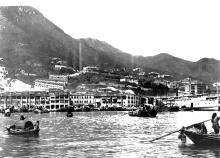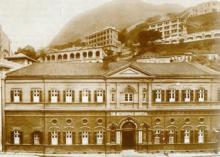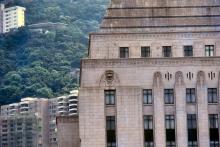London Mission House [1893- ]
Primary tabs
Submitted by annelisec on Sun, 2016-04-24 09:30
Current condition:
In use
Date Place completed:
1893-01-01
Originally built by the Daoji Mission House (the local Chinese congregation associated with the London Missionary Society) as Missionary housing, later Nurse's quarters for Nethersole Hospital, then vacant, and currently a private clubhouse for the adjacent apartment towers.
Tags:




Comments
AMO's report
They've declared it a Grade 2 listed building (http://www.aab.gov.hk/historicbuilding/en/316_Appraisal_En.pdf):
Historic Building Appraisal
London Mission Building
Nos. 78-80 Robinson Road, Mid-levels, Hong Kong
Historical Interest
Erected around 1893, London Mission Building (倫敦傳道會大樓) initially served as an office and residence for missionaries of the London Missionary Society (倫敦傳道會). In the 1930s it functioned as quarters for the medical staff working at hospitals in the immediate neighbourhood. In 1972, it was left vacant in the wake of the withdrawal of the London Missionary Society (LMS) from Hong Kong. In 2000, it was converted into a clubhouse for residents living in two nearby residential blocks in No. 80 Robinson Road built on the site of the former Nethersole Hospital.
While the building dates from around 1893, the close affiliations of the LMS with Hong Kong can be traced back to the 1840s when the first group of missionaries, notably the Rev. Dr. James Legge (1815-1897), arrived. The LMS earned its reputation through the work of preaching, teaching and healing. In addition to Ying Wa College, Ying Wa Girls’ School was founded in 1900 by Miss Helen Davies of the LMS. In the religious realm, the LMS helped form Hop Yat Church (合一堂), successor of the Daoji Mission House (道濟會堂),
in 1926. The LMS also made a great contribution to the formation of the predecessor of today’s Alice Ho Miu Ling Nethersole Hospital. With the financial assistance of Dr. Ho Kai, the Alice Memorial Hospital was built on the site purchased by the LMS in 1887 in commemoration of his wife Alice Ho, also an LMS missionary. Later the Nethersole Hospital was erected on LMS land in Bonham Road adjacent to the later Hop Yat Church (1926).
Architectural Merit
London Mission Building is a three-storey building actually comprised of two handed semi-detached houses separated by a central party wall. It is built on a platform formed by a massive stone retaining wall. The plan is rectangular with arcaded and colonnaded verandahs at each floor level along the front façade and projecting staircase enclosures at the rear. Servants’ quarters and storerooms are also situated at the rear. The roof is flat with several chimney stacks from fireplaces below.
The architectural style is Neo-Classical with Italianate and Regency influences. Walls are plainly rendered and painted. Windows are regularly spaced and divided into small glazing squares. Architectural features include
ornamental balustrading, bow shaped bay windows on the end elevations, and a wide projecting cornice at parapet level decorated with dentil mouldings.
Rarity, Built Heritage Value & Authenticity
Now well over 100 years old, London Mission Building is an elegant and rare piece of built heritage. Carefully renovated and restored for use as a clubhouse in 2002, it retains much of its original appearance and authenticity. Internally original wooden stairs can be seen. Verandah floors have been replaced with patterned quarry tiles in a suitable period style.
Social Value & Local Interest
The social value of the building lies in the role it played for the London Missionary Society, and as a reminder of the contributions made by the LMS to the well-being and development of Hong Kong through the work of preaching, teaching and healing.
Group Value
Today, most of the buildings in the vicinity such as Nethersole Hospital (1893), Alice Memorial Maternity Hospital (1904) and Ho Miu Ling Hospital (1906) have been demolished. However, Hop Yat Church and Ying Wa Girls’ School (all formerly owned by the LMS) remain to accompany the building as proof of evidence of the strong influence of the LMS in Hong Kong since the early colonial days.
Adaptive Re-use
As London Mission Building has recently been converted into a clubhouse, the question of adaptive re-use seems to have been answered for the present.